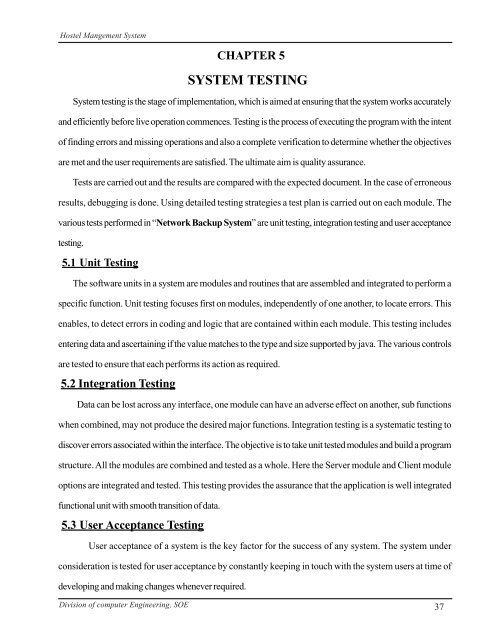hostel management system - DSpace at CUSAT - Cochin University ...
hostel management system - DSpace at CUSAT - Cochin University ...
hostel management system - DSpace at CUSAT - Cochin University ...
Create successful ePaper yourself
Turn your PDF publications into a flip-book with our unique Google optimized e-Paper software.
Hostel Mangement System<br />
CHAPTER 5<br />
SYSTEM TESTING<br />
System testing is the stage of implement<strong>at</strong>ion, which is aimed <strong>at</strong> ensuring th<strong>at</strong> the <strong>system</strong> works accur<strong>at</strong>ely<br />
and efficiently before live oper<strong>at</strong>ion commences. Testing is the process of executing the program with the intent<br />
of finding errors and missing oper<strong>at</strong>ions and also a complete verific<strong>at</strong>ion to determine whether the objectives<br />
are met and the user requirements are s<strong>at</strong>isfied. The ultim<strong>at</strong>e aim is quality assurance.<br />
Tests are carried out and the results are compared with the expected document. In the case of erroneous<br />
results, debugging is done. Using detailed testing str<strong>at</strong>egies a test plan is carried out on each module. The<br />
various tests performed in “Network Backup System” are unit testing, integr<strong>at</strong>ion testing and user acceptance<br />
testing.<br />
5.1 Unit Testing<br />
The software units in a <strong>system</strong> are modules and routines th<strong>at</strong> are assembled and integr<strong>at</strong>ed to perform a<br />
specific function. Unit testing focuses first on modules, independently of one another, to loc<strong>at</strong>e errors. This<br />
enables, to detect errors in coding and logic th<strong>at</strong> are contained within each module. This testing includes<br />
entering d<strong>at</strong>a and ascertaining if the value m<strong>at</strong>ches to the type and size supported by java. The various controls<br />
are tested to ensure th<strong>at</strong> each performs its action as required.<br />
5.2 Integr<strong>at</strong>ion Testing<br />
D<strong>at</strong>a can be lost across any interface, one module can have an adverse effect on another, sub functions<br />
when combined, may not produce the desired major functions. Integr<strong>at</strong>ion testing is a <strong>system</strong><strong>at</strong>ic testing to<br />
discover errors associ<strong>at</strong>ed within the interface. The objective is to take unit tested modules and build a program<br />
structure. All the modules are combined and tested as a whole. Here the Server module and Client module<br />
options are integr<strong>at</strong>ed and tested. This testing provides the assurance th<strong>at</strong> the applic<strong>at</strong>ion is well integr<strong>at</strong>ed<br />
functional unit with smooth transition of d<strong>at</strong>a.<br />
5.3 User Acceptance Testing<br />
User acceptance of a <strong>system</strong> is the key factor for the success of any <strong>system</strong>. The <strong>system</strong> under<br />
consider<strong>at</strong>ion is tested for user acceptance by constantly keeping in touch with the <strong>system</strong> users <strong>at</strong> time of<br />
developing and making changes whenever required.<br />
Division of computer Engineering, SOE 37
















